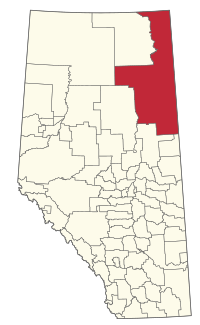Regional Municipality of Wood Buffalo facts for kids
Quick facts for kids
Wood Buffalo
|
||
|---|---|---|
|
Specialized municipality
|
||
| Regional Municipality of Wood Buffalo | ||
|
||

Location within Alberta
|
||
| Country | Canada | |
| Province | Alberta | |
| Region | Northern Alberta | |
| Planning region | Lower Athabasca | |
| Specialized municipality | April 1, 1995 | |
| Name change | August 14, 1996 | |
| Administrative office | Fort McMurray | |
| Area
(2021)
|
||
| • Land | 60,843.88 km2 (23,491.95 sq mi) | |
| Population
(2021)
|
||
| • Total | 82,400 | |
| • Density | 1.2/km2 (3/sq mi) | |
| • Municipal census (2021) | 75,555 | |
| Time zone | UTC−7 (MST) | |
| • Summer (DST) | UTC−6 (MDT) | |
The Regional Municipality of Wood Buffalo (RMWB) is a special kind of local government in northeast Alberta, Canada. It's super big, actually the largest municipality in North America by land area! This region is famous for its huge oil sand deposits, also known as the Athabasca oil sands.
Contents
History of Wood Buffalo
The area became a specialized municipality on April 1, 1995. This happened when the City of Fort McMurray and a nearby improvement district joined together. This special status helps manage a large urban area and a huge rural area with fewer people. The name changed to the Regional Municipality of Wood Buffalo on August 14, 1996.
Major Events in Wood Buffalo
Over the years, Wood Buffalo has faced some big challenges, especially with natural events.
Floods in 2013
In June 2013, after a lot of rain, the region declared a state of emergency. Some areas had to be evacuated, and people were told to boil their water. This was because local rivers, like the Hangingstone River, rose very high. Highway 63, an important road, also had to close.
Wildfire in 2016
One of the biggest events was the 2016 Fort McMurray wildfire starting on May 3, 2016. More than 80,000 people had to leave their homes. This was the largest evacuation ever in Alberta because of a wildfire.
Floods in 2020
In April 2020, a huge ice jam formed in the Athabasca River. This caused severe flooding in downtown Fort McMurray and nearby areas. About 13,000 people had to leave their homes. The flood caused over $520 million in insured damage.
Geography of Wood Buffalo
The Regional Municipality of Wood Buffalo is located in the northeast part of Alberta. It shares borders with Saskatchewan to the east and the Northwest Territories to the north. Other areas like Mackenzie County and Athabasca County are to its west and south.
The Athabasca River flows through the middle of Wood Buffalo, heading north into Lake Athabasca. Many other lakes are also found here, like Christina Lake and Gregoire Lake. The Slave River, which starts from Lake Athabasca, forms part of the region's northern border. You can also find interesting landforms like the Birch Mountains and Thickwood Hills.
Communities and Localities
Wood Buffalo is a large area with many different communities.
Hamlets in Wood Buffalo
These are smaller communities within the region:
- Anzac
- Conklin
- Fort Chipewyan
- Fort McKay
- Fort McMurray (this is the main urban service area)
- Gregoire Lake Estates
- Janvier South
- Saprae Creek
Other Localities and Settlements
The region also includes many smaller localities and settlements. These are often places with a few homes or specific historical importance.
- Almac Subdivision
- Beaver Lake-Young's Beach
- Bechtel Syncrude Camp
- Berdinskies
- Berny
- Big Eddy
- Billos
- Bitumount
- Brièreville
- Chard
- Charron
- Cheecham
- Christina Crossing
- Corbetts
- Devenish
- Dog Head
- Draper
- Egg Lake
- Embarras
- Embarras Portage
- Fitzgerald
- Fitzgerald 196
- Fitzgerald Settlement
- Fort Smith Settlement
- Gourin
- Grandin
- Improvement District No.143
- Kenny Woods
- Kinosis
- Le Goff
- Leismer
- Lenarthur
- Lynton
- Maloy
- Mariana Lake
- Mildred Lake
- Old Fort
- Pelican Settlement
- Pingle
- Point Brule
- Quigley
- Rossian
- Sandy Rapids
- Tar Island
- Waterways
- Willow Trail
- Wolyn
First Nations Reserves
Several First Nations have Indian reserves within the Regional Municipality of Wood Buffalo. These are special areas set aside for Indigenous communities.
- Allison Bay 219
- Charles Lake 225
- Chipewyan 201
- Chipewyan 201A
- Chipewyan 201B
- Chipewyan 201C
- Chipewyan 201D
- Chipewyan 201E
- Chipewyan 201F
- Chipewyan 201G
- Clearwater 175
- Collin Lake 223
- Cornwall Lake 224
- Cowper Lake 194A
- Devil's Gate 220
- Dog Head 218
- Fort McKay 174
- Fort McKay 174C
- Fort McKay 174D
- Gregoire Lake 176
- Hokedhe Tue 196E
- House River Indian Cemetery 178
- Janvier 194
- K'i Tue 196D
- Li Deze 196C
- Namur Lake 174B
- Namur River 174A
- Old Fort 217
- Sandy Point 221
- Thabacha Nare 196A
- Thebathi 196
- Tsu K'adhe Tue 196F
- Tsu Tue 196G
- Winefred Lake 194B
Rivers and Lakes
Wood Buffalo is in the lower part of the Athabasca River's watershed. Fort McMurray, the largest community, sits right on the banks of this river. Other important local rivers include the Hangingstone River and the Clearwater River.
The Hangingstone River flows into the Clearwater River near Fort McMurray. This river can have very high water levels in spring when snow melts or after heavy rain. The RMWB warns people about possible flash floods, especially near the Athabasca, Clearwater, and Christina rivers. Water levels are carefully watched, especially in spring, to give warnings about ice breaking up.
The Clearwater River is part of the Canadian Heritage Rivers System. It flows for 187 kilometers from Saskatchewan into Alberta before joining the Athabasca River. Because it doesn't have much oil sands development, the Clearwater River helps scientists study how natural river systems work.
Population and People
The Regional Municipality of Wood Buffalo is home to many people. The population has grown quite a bit over the years.
How Many People Live Here?
According to the 2021 Census, 72,326 people lived in Wood Buffalo. This was a small increase from 71,594 people in 2016. The area is very large, so the population density is quite low, meaning there aren't many people per square kilometer.
The local government also does its own count, called a municipal census. In 2021, the permanent population was 75,555. They also counted a "shadow population" of 30,504 non-permanent residents, like workers. This means the total number of people in the area at that time was 106,059.
Different Backgrounds
Wood Buffalo is a diverse place, with people from many different backgrounds.
| Panethnic group | 2021 | 2016 | 2011 | 2006 | 2001 | |||||
|---|---|---|---|---|---|---|---|---|---|---|
| Pop. | % | Pop. | % | Pop. | % | Pop. | % | Pop. | % | |
| European | 44,020 | 61.33% | 45,845 | 64.14% | 47,020 | 71.72% | 40,430 | 78.65% | 33,615 | 81.27% |
| Indigenous | 8,135 | 11.33% | 6,565 | 9.18% | 6,315 | 9.63% | 5,365 | 10.44% | 5,130 | 12.4% |
| Southeast Asian | 6,360 | 8.86% | 5,365 | 7.51% | 2,790 | 4.26% | 880 | 1.71% | 465 | 1.12% |
| African | 4,825 | 6.72% | 4,175 | 5.84% | 2,070 | 3.16% | 720 | 1.4% | 340 | 0.82% |
| South Asian | 4,770 | 6.65% | 4,980 | 6.97% | 4,085 | 6.23% | 1,780 | 3.46% | 640 | 1.55% |
| Middle Eastern | 1,505 | 2.1% | 1,940 | 2.71% | 1,215 | 1.85% | 830 | 1.61% | 475 | 1.15% |
| East Asian | 865 | 1.21% | 1,285 | 1.8% | 845 | 1.29% | 695 | 1.35% | 520 | 1.26% |
| Latin American | 645 | 0.9% | 925 | 1.29% | 1,035 | 1.58% | 570 | 1.11% | 75 | 0.18% |
| Other/multiracial | 650 | 0.91% | 400 | 0.56% | 295 | 0.45% | 140 | 0.27% | 105 | 0.25% |
| Total responses | 71,780 | 99.25% | 71,480 | 99.84% | 65,565 | 100% | 51,405 | 99.82% | 41,360 | 99.74% |
| Total population | 72,326 | 100% | 71,594 | 100% | 65,565 | 100% | 51,496 | 100% | 41,466 | 100% |
| Note: Totals greater than 100% due to multiple origin responses | ||||||||||
Languages Spoken
Many different languages are spoken in Wood Buffalo. While English is the most common, you'll also hear Tagalog, French, Arabic, and many others. This shows how many people from around the world have made Wood Buffalo their home.
| Mother tongue (2016) | Responses | % |
|---|---|---|
| English | 54,020 | 75.5% |
| Tagalog | 2,920 | 4.08% |
| French | 1,880 | 2.63% |
| Arabic | 1,270 | 1.78% |
| Gujarati | 1,070 | 1.5% |
| Urdu | 1,035 | 1.45% |
| Spanish | 805 | 1.13% |
| Somali | 730 | 1.02% |
| Amharic | 455 | 0.64% |
| Punjabi | 425 | 0.59% |
| Hindi | 415 | 0.58% |
| Mandarin | 335 | 0.47% |
| Knowledge of language (2016) | Responses | % |
|---|---|---|
| English | 70,750 | 98.99% |
| French | 5,125 | 7.17% |
| Tagalog | 4,250 | 5.95% |
| Arabic | 1,830 | 2.56% |
| Spanish | 1,375 | 1.92% |
| Urdu | 1,340 | 1.87% |
| Hindi | 1,130 | 1.58% |
| Gujarati | 1,130 | 1.58% |
| Somali | 730 | 1.02% |
| Punjabi | 640 | 0.9% |
| Mandarin | 580 | 0.81% |
| Cree | 535 | 0.75% |
Immigration to Wood Buffalo
Many people have moved to Wood Buffalo from other countries. Between 2001 and 2006, almost 2,000 new immigrants arrived. They came from places like India, the Philippines, Pakistan, Venezuela, and South Africa.
Religions
In 2001, most residents identified as Christian. Many others said they had no religious affiliation. Different Christian groups, like Roman Catholics and Anglicans, are present. There are also communities of Muslims and other faiths.
Economy of Wood Buffalo
The economy of Wood Buffalo is largely driven by its huge oil sand deposits. These deposits, also called the Athabasca Oil Sands, have made the region one of the fastest-growing industrial areas in Canada. This means many jobs and businesses are related to extracting and processing oil from these sands.
Parks and Attractions
Wood Buffalo is home to many natural attractions, including large parks and protected areas.
Wood Buffalo National Park
Wood Buffalo National Park is right next to the Regional Municipality of Wood Buffalo. It's a massive park, known for its wildlife and natural beauty.
Provincial Protected Areas
Several other provincial parks and wildland areas are found within Wood Buffalo. These places help protect the environment and offer opportunities for outdoor activities.
- Birch Mountains Wildland Provincial Park
- Birch River Wildland Provincial Park
- Dillon River Wildland Provincial Park
- Fidler-Greywillow Wildland Provincial Park
- Gipsy Lake Wildland Provincial Park
- Grand Rapids Wildland Provincial Park
- Gregoire Lake Provincial Park
- Kazan Wildland Provincial Park
- Kitaskino Nuwenëné Wildland Provincial Park
- Marguerite River Wildland Provincial Park
- Richardson Wildland Provincial Park
- Stony Mountain Wildland Provincial Park
- Whitemud Falls Wildland Provincial Park


